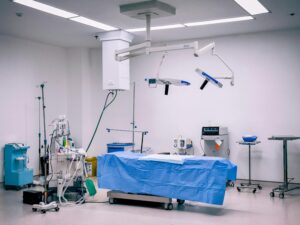Following disruptions like pandemics and geopolitical shifts, medical institutions are seeking stability. Additionally, they need to reduce costs and lead times for obtaining critical medical supplies and devices. For those reasons, the hospital supply chain is under immense pressure.
The solution lies in nearshoring within the healthcare sector, utilizing certified suppliers in the U.S. and Mexico. This enables high-volume hospitals and clinics to secure their supplies, reduce costs, and shorten delivery times, all without compromising the quality of patient care.
Why More Healthcare Institutions Are Nearshoring Device Procurement
The COVID-19 pandemic exposed the fragility of the globalized hospital supply chain model, revealing its heavy reliance on distant manufacturing hubs in Asia. The high ocean freight costs and delays, which can stretch to months, have become the norm, directly threatening the operational continuity of U.S. healthcare providers.
Consequently, the search for local alternatives is driven by two critical factors: supply chain resilience and cost reduction in the medical sector. Ramping up production in Mexico, particularly for high-volume medical devices and disposables, represents a robust contingency plan. This strategic shift helps to:
- Mitigate future risk of supply chain disruptions.
- Provide a more flexible pipeline.
- Establish a faster and more predictable delivery cycle.
By manufacturing closer to the U.S. market, hospitals can limit their dependence on single-source, overseas providers. This ensures a consistent and reliable flow of critical supplies, even in the event of global disruptions.
What Nearshoring Offers Beyond Lower Shipping Times
A shorter geographic distance means a faster time in transit, days instead of weeks or months. However, the strategic benefits of nearshoring between the U.S. and Mexico for medical device procurement extend far beyond logistics. Discover the key benefits of nearshoring healthcare.
Regulatory alignment
A significant advantage of medical device manufacturing in Mexico is the ease of navigating regulatory compliance. Reputable, certified facilities operate under rigorous quality systems, often holding both FDA (U.S.) and COFEPRIS (Mexico) certifications.
Furthermore, they are typically compliant with the ISO 13485 standard. This dual certification ensures that products seamlessly meet the high standards required for import and use in U.S. hospitals.
Inventory control and lower overhead
The advantage of shorter lead times is transformative for hospital finance and logistics. Nearshoring allows hospitals and high-volume clinics to fundamentally shift their sourcing strategy: moving away from a massive, expensive buffer stock to a more agile Just-in-Time (JIT) inventory model.
Since resupply takes days rather than months, institutions no longer need to tie up millions of dollars in inventory sitting in warehouses. This shift has three crucial financial benefits:
- It dramatically reduces storage costs. Less stock means less warehouse space, energy, and labor are required.
- It minimizes the risk of product obsolescence. When relying on distant suppliers, medical items with expiration dates risk spoiling or becoming outdated before they can be used. JIT minimizes this waste.
- It frees up capital. Instead of having significant funds tied up in static inventory, that capital can be reallocated to critical areas, such as technology upgrades, staffing, or patient services.
In essence, nearshoring transforms the hospital supply chain from a cost center into a leaner, more efficient operational asset.
Time zone and bilingual communication
Mexico shares time zones with the U.S., which facilitates closer communication and more efficient collaboration between hospital supply chain teams and the manufacturing plant. This is a stark contrast to the challenges of managing relationships and resolving issues with suppliers in Asia.
That model often requires working through the night. Furthermore, certified Mexican facilities frequently provide bilingual service and support. This eliminates language barriers, allowing for quicker problem-solving and smoother operational alignment, which in turn accelerates the overall procurement process.
Cost-competitive labor
Mexico offers a large pool of highly trained, skilled workers and technical staff in the medical device sector. Mexican labor costs are generally lower than those in the U.S. This contributes directly to a significant reduction in medical supply costs without sacrificing manufacturing quality.
How binational logistics improve fulfillment for U.S. Hospitals
The logistics infrastructure built along the U.S.–Mexico border is a cornerstone of the nearshoring advantage, specifically facilitating cross-border care and exchange. A prime example is the Juárez–El Paso corridor, a vital hub for the medical device industry.
Manufacturers in Ciudad Juárez benefit from sophisticated cross-border logistics services that ensure efficient customs clearance and rapid distribution into the U.S.
- Same-day delivery options. Special for urgent, high-demand items. The proximity enables same-day or next-day delivery to U.S. distribution centers or direct delivery to hospitals in Texas, New Mexico, and neighboring states.
- Trade Agreements. The USMCA (United States-Mexico-Canada Agreement) provides preferential market access and reduced tariffs, simplifying the process and contributing to overall cost savings.
Also, the specialized programs like Mexico’s IMMEX program reduce duties and taxes on imported medical inputs. This enables suppliers to offer more favorable financial terms to U.S. customers.
Assuring Quality While Meeting High-Volume Demands
A common concern when moving production is the belief that quality may be compromised. However, the Mexican medical device manufacturing sector has become a dominant global force precisely due to its commitment to rigorous quality standards.
Mexico is the leading exporter of medical devices in Latin America and consistently ranks among the top 10 globally. Certified facilities like RexMed maintain compliance at scale through the following methods:
- Advanced Quality Management Systems (QMS). These facilities employ a comprehensive, integrated QMS that is subject to continuous audits and validation, ensuring every batch meets the most stringent U.S. and international standards.
- Clean room manufacturing. High-volume devices for infusion therapy, ophthalmology, and surgery are produced in validated Clean Room environments to eliminate the risk of contamination.
- Skilled Workforce Specialization. Concentrated manufacturing clusters (such as those in Chihuahua or Baja California) have developed decades of expertise. They employ specialized, high-precision production techniques.
The best nearshoring partners integrate quality control at every stage of the supply chain process. From raw material sourcing to final packaging, we prove that high volume and quality can indeed go hand in hand.
How RexMed Helps Clinics and Hospitals
RexMed is an example of a certified supplier that has aligned its service model and production capabilities directly with the needs of the U.S. healthcare system. We are proudly specialized in producing a high volume of precision medical devices.
- Service model. RexMed operates as contract manufacturer. We offer customized projects that meet the unique needs of major national and multinational pharmaceutical groups, clinics, and hospital supply chains.
- More flexibility. We focus on flexibility, specializing in manual assembly, special testing, and quality production for both small and large lot sizes.
Production capabilities
Our facilities are strategically located to optimize cross-border logistics, for example, near the El Paso corridor. RexMed plants are certified and equipped for precision manufacturing across various applications, such as:
- Infusion and fluid delivery sets. Critical for IV therapy and pulmonary applications.
- Ophthalmic and cardiovascular components. Requiring the highest levels of assembly and precision.
- Specialized packaging and dispensing. Including innovative solutions that improve product function and patient safety.
Nearshoring through a certified, U.S.–Mexico–based partner, such as RexMed, provides a guarantee of cross-border care. More than just a supplier, we are a resilient manufacturing partner dedicated to ensuring On Time In Full (OTIF) deliveries. With us, you can rest assured and focus entirely on your patients.






